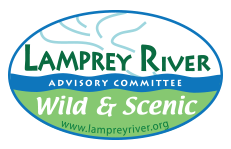The water that ultimately makes its way into the Lamprey comes from several sources: precipitation, overland runoff, and groundwater . On average, 20 inches per year of water comes from overland runoff. About half of this occurs during the months of March, April, and May. While in some watersheds low flows in summer and fall are augmented by adjacent aquifers, the Lamprey watershed contains relatively few aquifers in direct contact with the river. Instream flow, or the amount of water in the river at a given time, is important for several reasons:
- Low water levels cause a rise in temperature with sometimes severe impacts on aquatic organisms; for example, warm water holds much less oxygen for them than cold water.
- When flows are low, any contaminants become more concentrated, which can cause wastewater treatment plants to have difficulty meeting their permit requirements.
- Very low flows cause wetlands to dry up and expose river banks, making aquatic animals more vulnerable to predation by raccoons and other predators.
- The Lamprey River provides the largest volume of fresh water compared to other sources for and to the Great Bay Estuary. The volume and rhythm of flow to those ecosystems are critical to their health.
- Finally, humans are affected because a low river means less recreation, poorer water quality for swimming, and shortages for municipal and commercial water supplies.
The Lamprey River was one of the first rivers in New Hampshire to have an instream flow management plan. This plan was based on long-term flow data and was designed to ensure minimal flows to support aquatic life during extended drought. In 2022, NHDES began studying flows in the five main tributaries to determine how those flows might impact the Lamprey River. Near-realtime data for the main stem Lamprey River and five tributaries are linked below for those who are interested.
Lamprey River, USGS stream gages
Lamprey River Near Newmarket, NH - 01073500
Lamprey River at Langford Road, at Raymond, NH - 01073319
NHDES hosts information about the instream flow program and the New Hampshire Instream Flow Map viewer. This interactive web map allows users to view important protected instream flow data regarding New Hampshire designated rivers, including flow status of managed rivers and near real-time data from NHDES streamflow stations.

